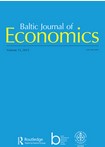Measurement and decomposition of Lithuania’s income inequality
Measurement and decomposition of Lithuania’s income inequality
Author(s): Nerijus Černiauskas, Andrius ČiginasSubject(s): National Economy, Labor relations, EU-Approach / EU-Accession / EU-Development, Fiscal Politics / Budgeting, Socio-Economic Research
Published by: BICEPS/SSE Riga
Keywords: Income inequality; factor decomposition; subgroup decomposition; Lithuania; European Union; Kakwani;
Summary/Abstract: Even though Lithuania’s household income inequality is among the highest in the European Union (EU), little empirical work has been carried out to explain such disparities. We investigate it using the EU Statistics on Income and Living Conditions sample microdata. We confirm that income inequality in Lithuania is high compared to the EU average. Our decompositions reveal that the number of employed household members in Lithuania’s households affects income inequality more as compared to the EU. It is related to a larger labour income, and self-employment income, in particular, contribution to inequality in Lithuania. Moreover, taxes, social contributions, and transfers reduce income inequality in Lithuania less than in the EU. Specifically, income taxes and social contributions are less progressive while transfers constitute a smaller share of income in Lithuania than in the EU. Income taxes and social contributions are effectively regressive for the selfemployed in Lithuania.
Journal: Baltic Journal of Economics
- Issue Year: 20/2020
- Issue No: 2
- Page Range: 139-169
- Page Count: 31
- Language: English

